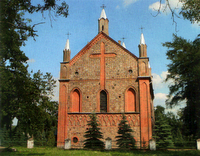The history of the small town of Zhuprany started at the beginning of the 15th century when the Great Duke Vitovt gave it as a present to Vilno Voevode Voiceh Monvid. For almost three hundred years it was owned by the famous Belarussian family Radzivills, who enjoyed hunting in Zhupranskaya Pushcha. At the end of the 18th century the small town and outskirts were named as Zhupranskoye County.
 The town had a wooden Genevan church a market square a mill and three inns: the Olkhovka, the Lipovka and Count Chapsky’s Inn. The town witnessed the retreat of French troops in 1812. Moral and physical degradation of the soldiers at Oshmyany was described by the French writer Count de Segure in his “History of Napoleon”. Many of legends surrounding Napoleon survived to this day. The locals too have one: it is about Napoleon hiding treasures not far from Zhuprany. Local historian Cheslav Yankovsky had several pages of his 1896 research text “Oshmyanski Povet” dedicated to Zhuprany.
The town had a wooden Genevan church a market square a mill and three inns: the Olkhovka, the Lipovka and Count Chapsky’s Inn. The town witnessed the retreat of French troops in 1812. Moral and physical degradation of the soldiers at Oshmyany was described by the French writer Count de Segure in his “History of Napoleon”. Many of legends surrounding Napoleon survived to this day. The locals too have one: it is about Napoleon hiding treasures not far from Zhuprany. Local historian Cheslav Yankovsky had several pages of his 1896 research text “Oshmyanski Povet” dedicated to Zhuprany.
Zhuprany has a close connection with the life and public and literary activities of the outstanding poet of the 19th century Frantishak Bogushevich. His ancestral manor is situated about 9 kilometres from the town.
The Grave of Poet Frantishak Bogushevich
The poet was buried in Zhuprany in 1900. Old residents recall that symbols of the poet’s work – a pipe, a bow and a violin – hung over his tomb for several years. In 1975 a stele with a bas-relief of Frantishak Bogushevich was erected. Since then Zhuprany has been turne into a kind of literary Mecca for Belarusians.
St.Peter and Paul Catholic Church
An impressive neo-Gothic church was built in Zhuprany in 1854-1890. Poet Bogushevich himself took an active part in the construction of this sanctuary. That is why in 1901 a marble memorial plate with his portrait was placed inside the church.
 The town had a wooden Genevan church a market square a mill and three inns: the Olkhovka, the Lipovka and Count Chapsky’s
The town had a wooden Genevan church a market square a mill and three inns: the Olkhovka, the Lipovka and Count Chapsky’s
No comments:
Post a Comment